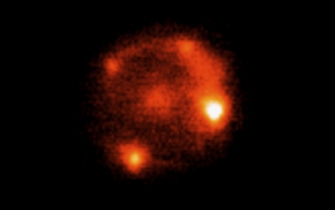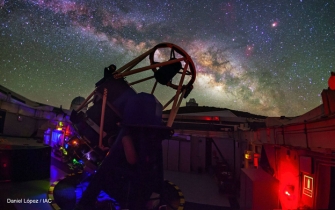
Artist's impression of a white dwarf "stealing" matter from a companion star. Credit: David A. Hardy
2017
10 MarchAre novae dusty cosmic cataclysms?
GROWTH Principal Investigator Mansi Kasliwal is among the recipients of the 2016 Scialog: Time-Domain Astrophysics award from the Research Corporation of Science Advancement (RCSA). The award, shared with Jeniffer Sokoloski from Columbia University will facilitate the study of the largely unexplored infrared dynamic sky and may help explain how dust forms around erupting white dwarf stars called novae.
During the 2016 Scialog conference organized by the RCSA, Mansi Kasliwal and Jeniffer Sokoloski proposed to peer deep into novae with a new wide-field infrared telescope, currently in development to investigate the possible presence and shape of dust clouds around them. The team was among the winners of the RCSA Scialog award designed to provide funding to high-risk/high reward research ideas born during their annual conferences.
Novae are bright outbursts that take place when a white dwarf accumulates material (mostly hydrogen) from a companion star until the temperature on the surface is so high that a thermonuclear fusion is ignited, and the excess material is ejected into space. Naturally then, dust clouds are not expected in the vicinity of binary systems that go nova. However, astronomers posited their existence as a way to explain the puzzling detection of high-energy gamma rays in novae by NASA’s Fermi Gamma-ray Space Telescope in 2010.
The thermonuclear fusion on the surface of a white dwarf provides a miniscule fraction of the energy needed to produce gamma rays. Another known mechanism to generate gamma rays is to accelerate particles to relativistic speeds in shock waves. The latter requires the ejected material from the white dwarf to collide with some other medium. This prompted scientists to suggest the presence of dust clouds around novae.
Astrophysicists have started to propose models that try to explain how dust can form in the hostile environment of novae. One of them, known as the “shock-dust” model, suggests that the gas, which is behind the shock waves that produce the gamma rays, can cool quickly and clump into a doughnut-shape dust cloud around the white dwarf. To test this and other models, Kasliwal and Sokoloski plan to use data from a new telescope called Gattini-IR on the Palomar mountain, which will capture the infrared radiation from novae. Unlike light in the optical, infrared rays can travel through dusty environments allowing astronomers to peek deep into novae and study the morphology of gas clouds around them.
Gattini-IR will have a wide field infrared camera that will capture the infrared radiation from a band of wavelengths centered at 1.25 micrometers. Electromagnetic waves in this so called J-band can travel through the Earth’s atmosphere which is otherwise mostly opaque to infrared. The camera will image the entire Northern sky every night and it serves as a technology pathfinder to an even more sensitive system which will be built at a polar location to systematically chart the dynamic infrared sky. Gattini-IR is a joint initiative between Caltech (co-PI Mansi M. Kasliwal) and Australian National University (co-PI Anna Moore) supported by the Mt Cuba Astronomical Foundation. The Scialog award will help to further advance the ongoing development of the wide-field imager.
Kasliwal and Sokoloski were among the seven collaborative teams (16 Scialog Fellows) awarded a total of $730,000 among at the 2016 Scialog: Time Domain Astrophysics (TDA) conference held in Tucson, Arizona. The event brought together 50 leading young astronomers and astrophysicists, joined by 10 distinguished senior scientists, who engaged in intensive discussions designed to produce creative ideas for innovative research.
Contact
Iva Kostadinova
GROWTH Communications and Media Contact
ivonata@caltech.edu
+1 626 395 2952




